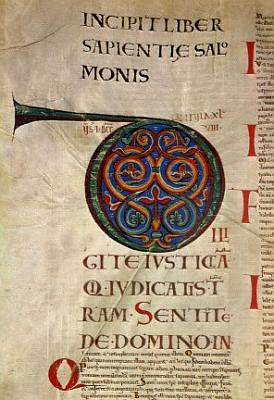Okej so... Finally I decided to put here this topic...

Codex Gigas alias Devil‘s Bible
In the beginning of 13th century was in Czech Republic made a literary work known as Devil’s Bible (Djävulsbibeln in Swedish). Uknown author wrote and supplied with chromatic iluminations a huge book. Graphologists and historians agree on fact that the book is basically written by one author. For his anonymity is he called „The Great scriber“.
According to legend – there was a monk living in monastery placed in Podlazice on the east of Czech Kingdom (Bohemia). For his sinful deed he was sentenced to immure alive. Desperately he was thinking about how to pass up the cruel punishment. And because he was a very handy scriber he proposed abbot to transribe Holi Writ as way of his penitence. The abbot was obviously a wise man and agreed with it. Monk started to write during days and nights – but soon he learned the promise is unrealizable. Be at loss he cry out devil for help. On legend say that monk panted portrait of „green devil“ as requirement (within his soul will fail to hell). Although punishmet was pardoned his life turned devil. Compunctions persecuted him and he run from place to place. After long divagate he fell down to statue of Virgin Mary and begged her for salvation. Mother of god heard him out and sent angels to manage a struggle with infernal master and get back the note (for soul) Godlike warriors vanquished and bring back the devilish document right in moment of monk’s death.
That way was his soul redemptioned and angels took his soul to heaven.
The largest manuscript in the world
The writing is called „Book of books“ or Library in one book“. Last ages gave it superlatives as Codex giganteus, Liber pergrandis, Gigas Librorum, etc… First refrences about Devil’s Bible came from 1295 – but it’s supposed to be a half century older. Most probably it was created about 1229 in milieu of small Benedictine monastery of Podlazice near Chrudim. We don’t have any documents about author, creation and it’s reason.
The codex is contained in a wooden folder, covered with leather and ornamented with metal. At 92cm (36.2in.) tall, 50cm (19.7in.) wide and 22cm (8.6in.) thick it is the largest known medieval manuscript. It initially contained 320 vellum sheets, though eight of these pages were subsequently removed. It is unknown who removed the pages or for what purpose but it seems likely that they contained the monastic rules of the Benedictines. The codex weighs nearly 75 kg (165lbs.), the vellum used having been prepared from the skins of 160 asses. From anknown reasons someone cut out 8 pages.
What does Codex Gigas hide?In the book isn’t typed in not only completely text of Scripture, but Cosmae Pragensis Chronica Boemorum, number of tractates, calendar with necrologues, list of Podlažice’s fraternity, magic formulas and lot of contemporary notes.
The manuscript has a rare decoration including illuminations in red, blue, yellow, green and gold.
- Book begins with notation of three alphabet: Hebrew, Greek and Latin. Later in 14th century was wrotein also Glagolitic and Cyrillic alphabet.
- Eigen text of the book begins with
Scripture – The Old Testament (it takes first 118 pages)
- Then come after two historical works called
Antiquities of the Jews, written by Josephus (Titus Flavius Josephus), who was living in Rome between 37 – 95 AD.
- Next text construct from
Etymologiae, which wrote pontiff Isidor of Seville Before his death in 636 AD.
- Two dissertations of Galen. Discourse about human anatomy.
- On pages 253 – 286 is written
The New Testament in pre-Vulgate version.
-
Penitentiary with extended description of instructions for confessors; how large the penitence has to be for every particular sins; mention a statement of all basic priestlike nuisances. Whereas every passage begins in words: „I commit a sin…“ and ends „…therein I plead guilty.“
- Right at page 290 lie the largest sight – There’s illustrated almost 50 cm high shape of devil. The devil is enframed with two towers. He has four fingers on every limb. Face is green with two tongues, which means doubleness of his speech. His head decorate two horns. On second page is picture of big city with spires, churches and cathedrals. Supposedly is it Jerusalem.

- Pages coming after are darksome both outward – and content. There’s magical formulas, medical formulas, etc…
- After this chapter, on pages 294 – 304, is written
Chronicle of Bohemia by Cosmas of Prague (who was a provost of Prague’s canonry).
- Another 8 pages, later cut out probably contained regular rules of Benedictine friary.
- End of the Codex construct list of memebers of Podlažice’s fraternity, wrote up between 1227 – 1229.
- The last text – Benedictine calendar completed with necrology of dead people (1635 in sum).
- Pure ending contains listin of days, which will fall on Easter in oncoming years.
History in shortcut:The codex was created in the Benedictine monastery of Podlažice near Chrudim, which was destroyed during the 15th century. Records in the codex end in the year 1229. The codex was later pledged to the Cistercians Sedlec monastery and then bought by the Benedictine monastery in Břevnov. From 1477-1593 it was kept in the library of a monastery in Broumov until it was taken to Prague in 1594 to form a part of the collections of Rudolf II.
On the end of the Thirty Years' War in the year 1648, the entire collection was taken by the Swedish army as plunder. Since 1649 the manuscript has been kept in the Swedish Royal Library in Stockholm -
http://www.kb.se/Hs/Eng/djavueng.htm. The site of its creation is marked by a maquette in the town museum of Chrást.
(Ähm, I was lazy to translate the extended version from Czech, so I stole this short from Wiki...)
